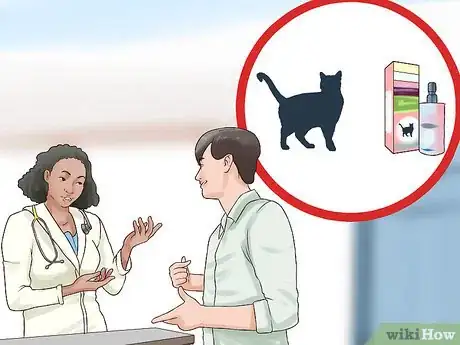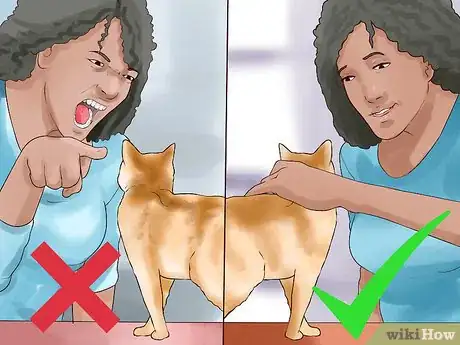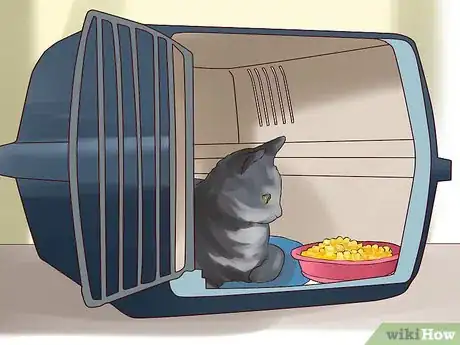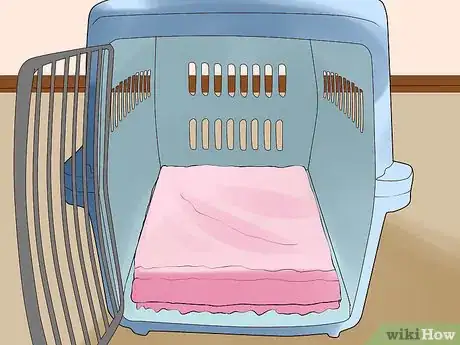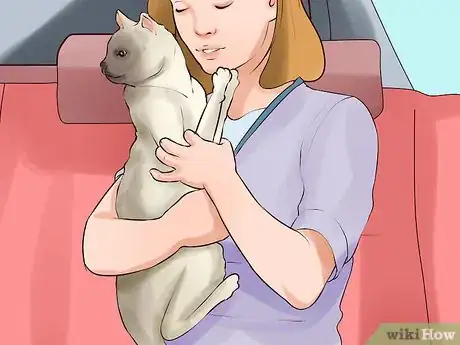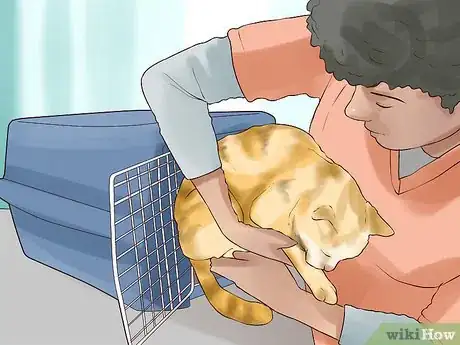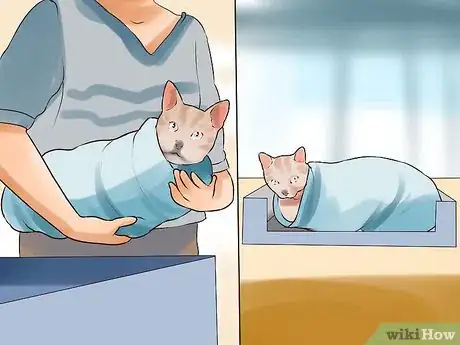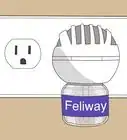This article was co-authored by Lauren Baker, DVM, PhD. Dr. Lauren Baker is a Veterinarian and Assistant Scientist at the University of Wisconsin-Madison. With over 10 years in veterinary medicine, she specializes in the concept of “one health,” which uses insights from veterinary medicine to help human medical research. She holds a Ph.D. in Comparative Biomedical Sciences, a Doctor of Veterinary Medicine, an MS in Comparative Biomedical Sciences, and a Bachelor’s degree in Psychology from the University of Wisconsin-Madison.
There are 18 references cited in this article, which can be found at the bottom of the page.
This article has been viewed 35,397 times.
Moving or traveling can be a taxing time for humans—it can be even more hectic for your cat! Cats are the defenders of territory, lovers of routine, and rulers of ritual. Disturbing their surroundings and schedule can cause your feline friend and lot of stress.[1] If your cat is particularly nervous, it is important to plan ahead to make sure your pet is as comfortable and safe as possible during his or her journey.
Steps
Planning Ahead
-
1Talk to a veterinarian. It is important to discuss your options with a veterinarian before your journey. He or she will be able to determine your cat’s needs, offer sound advice, and prescribe a mild sedative or anti-nausea medication to help alleviate your cat’s nervous tendencies.[2] It is also wise to discuss any required changes to your cat’s existing medications.[3]
- Discuss the option of using a synthetic feline pheromone spray with your cat’s veterinarian. This may also be a useful option for helping your cat’s stress levels during and leading up to transport.[4]
-
2Change your behavior. Remaining calm and acting normally may alleviate some of your cat’s anxiety prior to your journey. Allowing your cat to move freely about the house and avoiding eye contact will help establish a peaceful, shared environment for you and your cat.[5]
- Stressed out cats will often yowl or meow loudly, so make sure that you are prepared for this. Do not raise your voice or become angry with your cat. This can reinforce an already nervous cat’s anxieties and fears.[6]
Advertisement -
3Introduce your cat to the car. A nervous cat is calmer when he or she is in familiar territory. Cars can be loud, intimidating environments, so it is important to introduce your cat to the vehicle gradually.[7]
- Practice bringing your cat out to the car in small intervals, providing treats when the cat remains calm. Gradually repeat this process several times, making your cat wait a little longer each time to earn a treat. If your cat is nervous, limit the time spent in the vehicle and do not offer a treat.
- Once your cat no longer acts nervous in your vehicle, practice driving a short distance and reward your cat when he or she remains calm. Provided that your cat is not acting nervous, extend the trips each time and reward good behavior with a treat. Over time, your cat will be much more familiar, comfortable, and at ease in your moving vehicle.[8]
Transporting Your Cat in a Crate
-
1Introduce the carrier crate early. Most frequently, your cat will only see the carrier crate just prior to a trip, which may cause anxiety and stress. It is important for all cats to become accustomed to their carriers, but this is particularly beneficial for nervous cats. Leaving the crate out in the open at all times will help prevent your cat from solely associating it with transportation.[9]
- Place your cat’s food or treats inside the crate. This will offer a positive association with the crate; if there is yummy food inside, it surely can’t be a bad place![10]
- Placing comfortable bedding and familiar and favorite toys within the crate can also set your cat’s anxieties at ease.[11] Your cat may start to use the carrier as a hideout, which is exactly what you want to happen.
-
2Place a towel in the crate. When the day of travel arrives, place a towel in the floor of the crate. This will help clean up any accidents your cat may have during travel and will keep your cat clean.[12]
-
3
-
4Lower the cat inside. Slowly lower the cat inside the crate, bottom first.[15] This will help prevent a nervous cat from feeling that they are being forced inside or are being trapped.[16]
- You may want to find a carrier that opens from the top instead of from the side. This will make it much easier to put your cat into the crate because the opening will be wider.
-
5Cover with a light blanket. Once the cat is inside, cover the carrier with a towel or light blanket. This will help keep the cat calm and prevent motion sickness.[17]
Transporting Your Cat in a Towel
-
1Grab a towel. If an emergency arises and you do not have a crate or a harness to transport your cat, wrap your cat gently with a towel. Wrapping a nervous cat in a towel can help prevent injury to both you and your cat, as well as help the cat feel safe and secure.[18]
-
2Lay the towel flat. On a flat surface, gently place your cat in the middle of the towel, several inches from the top.
-
3Fold the towel over the cat. Pull the short end of the towel over the cat’s neck and body, and tug the corner of the towel forward. Tuck the towel corner under the cat’s neck.
- Make sure that the towel is not too tight around your cat’s neck. You should be able to fit two fingers in between the towel and the cat’s neck so that your cat is snugly wrapped but can still breathe easily.
-
4Tuck the cat in. Grab the opposite side of the towel and gently pull it over the cat’s body and tuck it beneath the belly. Make sure that it fits securely but comfortably and that the cat’s head is not covered or restrained.[19]
-
5Pick up your cat. Slowly lift your cat and place him or her an open-top box.[20]
Warnings
- Using a laundry basket or a makeshift carrier such as a cardboard box or a pillow case is not recommended. This can be dangerous and traumatic to the animal.[22]⧼thumbs_response⧽
- Your cat could be seriously harmed if the airbag deploys while your cat is in the front seat. Be sure that your cat is safely secured in the back seat.[23]⧼thumbs_response⧽
- Be aware of your cat’s behavior after your journey. Some cats may vomit, experience diarrhea, or have abnormal sleep patterns after being transported to a new place. If the symptoms do not resolve within two days, visit a veterinarian as soon as possible.[24]⧼thumbs_response⧽
References
- ↑ http://www.livescience.com/34473-why-cats-hate-car-rides.html
- ↑ http://www.hillspet.com/en/us/cat-care/routine-care/moving-with-cats
- ↑ http://www.vetstreet.com/learn/preparing-for-a-road-trip-with-your-cat
- ↑ http://www.hillspet.com/en/us/cat-care/routine-care/moving-with-cats
- ↑ http://icatcare.org/advice/problem-behaviour/anxious-cats
- ↑ http://icatcare.org/advice/problem-behaviour/anxious-cats
- ↑ https://www.petfinder.com/cats/living-with-your-cat/cat-travel-tips-cars/
- ↑ https://www.petfinder.com/cats/living-with-your-cat/cat-travel-tips-cars/
- ↑ http://www.cat-world.com.au/General-Cat-Articles/travelling-with-cats.html
- ↑ https://www.petfinder.com/cats/cat-problems/cat-hates-carrier/
- ↑ https://www.petfinder.com/cats/cat-problems/cat-hates-carrier/
- ↑ http://www.banfield.com/pet-health-resources/pet-health-concerns/pet-safety-tips/a-guide-to-getting-your-cat-in-a-pet-carrier
- ↑ https://www.vetbabble.com/cats/travel-cats/cat-car-carrier-tips/
- ↑ http://www.banfield.com/pet-health-resources/pet-health-concerns/pet-safety-tips/a-guide-to-getting-your-cat-in-a-pet-carrier
- ↑ https://www.vetbabble.com/cats/travel-cats/cat-car-carrier-tips/
- ↑ http://www.banfield.com/pet-health-resources/pet-health-concerns/pet-safety-tips/a-guide-to-getting-your-cat-in-a-pet-carrier
- ↑ http://www.banfield.com/pet-health-resources/pet-health-concerns/pet-safety-tips/a-guide-to-getting-your-cat-in-a-pet-carrier
- ↑ http://www.vetstreet.com/our-pet-experts/towel-wrap-your-cat-in-5-scratch-free-steps
- ↑ https://elginvethospital.com/2015/02/27/how-to-safely-burrito-a-cat-or-small-exotic-animal-when-medicating/
- ↑ http://www.aspca.org/pet-care/general-pet-care/emergency-care-your-pet
- ↑ http://www.vetstreet.com/learn/preparing-for-a-road-trip-with-your-cat
- ↑ http://www.banfield.com/pet-health-resources/pet-health-concerns/pet-safety-tips/a-guide-to-getting-your-cat-in-a-pet-carrier
- ↑ http://www.humanesociety.org/animals/resources/tips/traveling_tips_pets_ships_planes_trains.html
- ↑ https://www.pethub.com/article/pet-care/tips-on-how-to-move-or-travel-with-your-cat
About This Article
Before you transport your nervous cat, first try gradually introducing it to your car by bringing it out for few minutes at a time, which will help it become familiar with the new environment. You should also introduce your cat to the carrier you’ll be using so it can get accustomed to it. Make sure to place bedding, food, and treats in the carrier to make it as inviting as you can. When it’s time to transport your cat, calmly pick it up with one hand holding its front legs and one hand supporting its bottom. Then, slowly lower your cat into its crate, bottom first, so it doesn’t feel like it’s being forced inside. Once your cat is inside, try putting a towel over the crate to help it stay calm and prevent motion sickness. To learn how to wrap your cat in a towel to ease its anxiety, read more from our Veterinary co-author.
